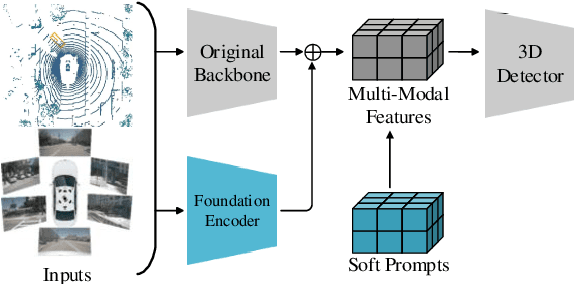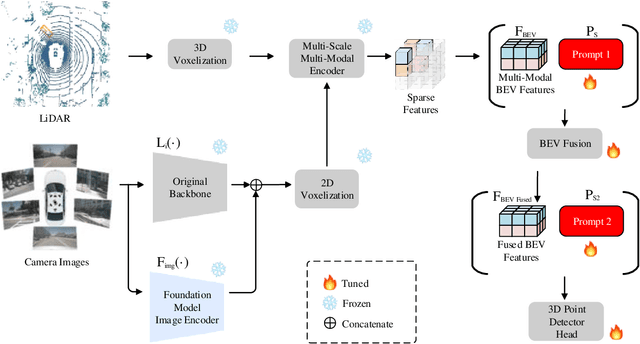Guanghui Wang
Department of Computer Science, Ryerson University, Toronto, ON, Canada M5B 2K3
T-CACE: A Time-Conditioned Autoregressive Contrast Enhancement Multi-Task Framework for Contrast-Free Liver MRI Synthesis, Segmentation, and Diagnosis
Aug 13, 2025Abstract:Magnetic resonance imaging (MRI) is a leading modality for the diagnosis of liver cancer, significantly improving the classification of the lesion and patient outcomes. However, traditional MRI faces challenges including risks from contrast agent (CA) administration, time-consuming manual assessment, and limited annotated datasets. To address these limitations, we propose a Time-Conditioned Autoregressive Contrast Enhancement (T-CACE) framework for synthesizing multi-phase contrast-enhanced MRI (CEMRI) directly from non-contrast MRI (NCMRI). T-CACE introduces three core innovations: a conditional token encoding (CTE) mechanism that unifies anatomical priors and temporal phase information into latent representations; and a dynamic time-aware attention mask (DTAM) that adaptively modulates inter-phase information flow using a Gaussian-decayed attention mechanism, ensuring smooth and physiologically plausible transitions across phases. Furthermore, a constraint for temporal classification consistency (TCC) aligns the lesion classification output with the evolution of the physiological signal, further enhancing diagnostic reliability. Extensive experiments on two independent liver MRI datasets demonstrate that T-CACE outperforms state-of-the-art methods in image synthesis, segmentation, and lesion classification. This framework offers a clinically relevant and efficient alternative to traditional contrast-enhanced imaging, improving safety, diagnostic efficiency, and reliability for the assessment of liver lesion. The implementation of T-CACE is publicly available at: https://github.com/xiaojiao929/T-CACE.
Pyramid Hierarchical Masked Diffusion Model for Imaging Synthesis
Jul 22, 2025Abstract:Medical image synthesis plays a crucial role in clinical workflows, addressing the common issue of missing imaging modalities due to factors such as extended scan times, scan corruption, artifacts, patient motion, and intolerance to contrast agents. The paper presents a novel image synthesis network, the Pyramid Hierarchical Masked Diffusion Model (PHMDiff), which employs a multi-scale hierarchical approach for more detailed control over synthesizing high-quality images across different resolutions and layers. Specifically, this model utilizes randomly multi-scale high-proportion masks to speed up diffusion model training, and balances detail fidelity and overall structure. The integration of a Transformer-based Diffusion model process incorporates cross-granularity regularization, modeling the mutual information consistency across each granularity's latent spaces, thereby enhancing pixel-level perceptual accuracy. Comprehensive experiments on two challenging datasets demonstrate that PHMDiff achieves superior performance in both the Peak Signal-to-Noise Ratio (PSNR) and Structural Similarity Index Measure (SSIM), highlighting its capability to produce high-quality synthesized images with excellent structural integrity. Ablation studies further confirm the contributions of each component. Furthermore, the PHMDiff model, a multi-scale image synthesis framework across and within medical imaging modalities, shows significant advantages over other methods. The source code is available at https://github.com/xiaojiao929/PHMDiff
Beyond Node Attention: Multi-Scale Harmonic Encoding for Feature-Wise Graph Message Passing
May 21, 2025Abstract:Conventional Graph Neural Networks (GNNs) aggregate neighbor embeddings as holistic vectors, lacking the ability to identify fine-grained, direction-specific feature relevance. We propose MSH-GNN (Multi-Scale Harmonic Graph Neural Network), a novel architecture that performs feature-wise adaptive message passing through node-specific harmonic projections. For each node, MSH-GNN dynamically projects neighbor features onto frequency-sensitive directions determined by the target node's own representation. These projections are further modulated using learnable sinusoidal encodings at multiple frequencies, enabling the model to capture both smooth and oscillatory structural patterns across scales. A frequency-aware attention pooling mechanism is introduced to emphasize spectrally and structurally salient nodes during readout. Theoretically, we prove that MSH-GNN approximates shift-invariant kernels and matches the expressive power of the 1-Weisfeiler-Lehman (1-WL) test. Empirically, MSH-GNN consistently outperforms state-of-the-art models on a wide range of graph and node classification tasks. Furthermore, in challenging classification settings involving joint variations in graph topology and spectral frequency, MSH-GNN excels at capturing structural asymmetries and high-frequency modulations, enabling more accurate graph discrimination.
Keypoints as Dynamic Centroids for Unified Human Pose and Segmentation
May 17, 2025Abstract:The dynamic movement of the human body presents a fundamental challenge for human pose estimation and body segmentation. State-of-the-art approaches primarily rely on combining keypoint heatmaps with segmentation masks but often struggle in scenarios involving overlapping joints or rapidly changing poses during instance-level segmentation. To address these limitations, we propose Keypoints as Dynamic Centroid (KDC), a new centroid-based representation for unified human pose estimation and instance-level segmentation. KDC adopts a bottom-up paradigm to generate keypoint heatmaps for both easily distinguishable and complex keypoints and improves keypoint detection and confidence scores by introducing KeyCentroids using a keypoint disk. It leverages high-confidence keypoints as dynamic centroids in the embedding space to generate MaskCentroids, allowing for swift clustering of pixels to specific human instances during rapid body movements in live environments. Our experimental evaluations on the CrowdPose, OCHuman, and COCO benchmarks demonstrate KDC's effectiveness and generalizability in challenging scenarios in terms of both accuracy and runtime performance. The implementation is available at: https://sites.google.com/view/niazahmad/projects/kdc.
Autoencoder-Based Hybrid Replay for Class-Incremental Learning
May 09, 2025Abstract:In class-incremental learning (CIL), effective incremental learning strategies are essential to mitigate task confusion and catastrophic forgetting, especially as the number of tasks $t$ increases. Current exemplar replay strategies impose $\mathcal{O}(t)$ memory/compute complexities. We propose an autoencoder-based hybrid replay (AHR) strategy that leverages our new hybrid autoencoder (HAE) to function as a compressor to alleviate the requirement for large memory, achieving $\mathcal{O}(0.1 t)$ at the worst case with the computing complexity of $\mathcal{O}(t)$ while accomplishing state-of-the-art performance. The decoder later recovers the exemplar data stored in the latent space, rather than in raw format. Additionally, HAE is designed for both discriminative and generative modeling, enabling classification and replay capabilities, respectively. HAE adopts the charged particle system energy minimization equations and repulsive force algorithm for the incremental embedding and distribution of new class centroids in its latent space. Our results demonstrate that AHR consistently outperforms recent baselines across multiple benchmarks while operating with the same memory/compute budgets. The source code is included in the supplementary material and will be open-sourced upon publication.
ABKD: Pursuing a Proper Allocation of the Probability Mass in Knowledge Distillation via $α$-$β$-Divergence
May 07, 2025Abstract:Knowledge Distillation (KD) transfers knowledge from a large teacher model to a smaller student model by minimizing the divergence between their output distributions, typically using forward Kullback-Leibler divergence (FKLD) or reverse KLD (RKLD). It has become an effective training paradigm due to the broader supervision information provided by the teacher distribution compared to one-hot labels. We identify that the core challenge in KD lies in balancing two mode-concentration effects: the \textbf{\textit{Hardness-Concentration}} effect, which refers to focusing on modes with large errors, and the \textbf{\textit{Confidence-Concentration}} effect, which refers to focusing on modes with high student confidence. Through an analysis of how probabilities are reassigned during gradient updates, we observe that these two effects are entangled in FKLD and RKLD, but in extreme forms. Specifically, both are too weak in FKLD, causing the student to fail to concentrate on the target class. In contrast, both are too strong in RKLD, causing the student to overly emphasize the target class while ignoring the broader distributional information from the teacher. To address this imbalance, we propose ABKD, a generic framework with $\alpha$-$\beta$-divergence. Our theoretical results show that ABKD offers a smooth interpolation between FKLD and RKLD, achieving an effective trade-off between these effects. Extensive experiments on 17 language/vision datasets with 12 teacher-student settings confirm its efficacy. The code is available at https://github.com/ghwang-s/abkd.
VISUALCENT: Visual Human Analysis using Dynamic Centroid Representation
Apr 26, 2025Abstract:We introduce VISUALCENT, a unified human pose and instance segmentation framework to address generalizability and scalability limitations to multi person visual human analysis. VISUALCENT leverages centroid based bottom up keypoint detection paradigm and uses Keypoint Heatmap incorporating Disk Representation and KeyCentroid to identify the optimal keypoint coordinates. For the unified segmentation task, an explicit keypoint is defined as a dynamic centroid called MaskCentroid to swiftly cluster pixels to specific human instance during rapid changes in human body movement or significantly occluded environment. Experimental results on COCO and OCHuman datasets demonstrate VISUALCENTs accuracy and real time performance advantages, outperforming existing methods in mAP scores and execution frame rate per second. The implementation is available on the project page.
PF3Det: A Prompted Foundation Feature Assisted Visual LiDAR 3D Detector
Apr 04, 2025



Abstract:3D object detection is crucial for autonomous driving, leveraging both LiDAR point clouds for precise depth information and camera images for rich semantic information. Therefore, the multi-modal methods that combine both modalities offer more robust detection results. However, efficiently fusing LiDAR points and images remains challenging due to the domain gaps. In addition, the performance of many models is limited by the amount of high quality labeled data, which is expensive to create. The recent advances in foundation models, which use large-scale pre-training on different modalities, enable better multi-modal fusion. Combining the prompt engineering techniques for efficient training, we propose the Prompted Foundational 3D Detector (PF3Det), which integrates foundation model encoders and soft prompts to enhance LiDAR-camera feature fusion. PF3Det achieves the state-of-the-art results under limited training data, improving NDS by 1.19% and mAP by 2.42% on the nuScenes dataset, demonstrating its efficiency in 3D detection.
Atten-Transformer: A Deep Learning Framework for User App Usage Prediction
Feb 24, 2025Abstract:Accurately predicting smartphone app usage patterns is crucial for user experience optimization and targeted marketing. However, existing methods struggle to capture intricate dependencies in user behavior, particularly in sparse or complex usage scenarios. To address these challenges, we introduce Atten-Transformer, a novel model that integrates temporal attention with a Transformer network to dynamically identify and leverage key app usage patterns. Unlike conventional methods that primarily consider app order and duration, our approach employs a multi-dimensional feature representation, incorporating both feature encoding and temporal encoding to enhance predictive accuracy. The proposed attention mechanism effectively assigns importance to critical app usage moments, improving both model interpretability and generalization. Extensive experiments on multiple smartphone usage datasets, including LSapp and Tsinghua App Usage datasets, demonstrate that Atten-Transformer consistently outperforms state-of-the-art models across different data splits. Specifically, our model achieves a 45.24\% improvement in HR@1 on the Tsinghua dataset (Time-based Split) and a 18.25\% improvement in HR@1 on the LSapp dataset (Cold Start Split), showcasing its robustness across diverse app usage scenarios. These findings highlight the potential of integrating adaptive attention mechanisms in mobile usage forecasting, paving the way for enhanced user engagement and resource allocation.
Multi-Agent Performative Prediction Beyond the Insensitivity Assumption: A Case Study for Mortgage Competition
Feb 12, 2025Abstract:Performative prediction models account for feedback loops in decision-making processes where predictions influence future data distributions. While existing work largely assumes insensitivity of data distributions to small strategy changes, this assumption usually fails in real-world competitive (i.e. multi-agent) settings. For example, in Bertrand-type competitions, a small reduction in one firm's price can lead that firm to capture the entire demand, while all others sharply lose all of their customers. We study a representative setting of multi-agent performative prediction in which insensitivity assumptions do not hold, and investigate the convergence of natural dynamics. To do so, we focus on a specific game that we call the ''Bank Game'', where two lenders compete over interest rates and credit score thresholds. Consumers act similarly as to in a Bertrand Competition, with each consumer selecting the firm with the lowest interest rate that they are eligible for based on the firms' credit thresholds. Our analysis characterizes the equilibria of this game and demonstrates that when both firms use a common and natural no-regret learning dynamic -- exponential weights -- with proper initialization, the dynamics always converge to stable outcomes despite the general-sum structure. Notably, our setting admits multiple stable equilibria, with convergence dependent on initial conditions. We also provide theoretical convergence results in the stochastic case when the utility matrix is not fully known, but each learner can observe sufficiently many samples of consumers at each time step to estimate it, showing robustness to slight mis-specifications. Finally, we provide experimental results that validate our theoretical findings.
 Add to Chrome
Add to Chrome Add to Firefox
Add to Firefox Add to Edge
Add to Edge